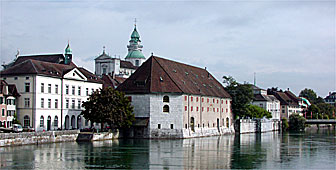Pocket-sized Solothurn is Switzerland’s surprise package

The city of Solothurn is one of the country's best-kept secrets. Claimed by many to be the "best-preserved" Baroque city in Switzerland, it remains largely ignored despite its proximity to the capital Bern.
“Tourists think of going to Bern, Lucerne or Zurich rather than Solothurn,” says Marianne Schwaller of the local tourist board. “Solothurn is not the first place that comes to people’s minds when they visit Switzerland.”
Travelling there by rail or road fails to give the visitor a true appreciation of what is to follow. Even getting off the train in Solothurn, it is difficult to believe the city has much to offer.
It only takes five minutes to discover that first impressions are wrong. There is one building in Solothurn that no visitor can fail to see from afar, the cathedral.
Simply by walking towards the church and crossing the Aare River, you leave the late 20th century surroundings behind and enter the past. The past in this case is an old town, often called the “best-preserved” Baroque city in Switzerland.
French bring wealth
The Baroque influence is the direct result of Solothurn serving as the French ambassador’s home from the mid-16th century until 1789. The king of France’s representative to the Swiss cantons didn’t just live there, he also brought wealth and a way of life.
But to call the town just a Baroque city is a misnomer.
“The city as you see it dates back to the Middle Ages, with Baroque touches,” says Markus Hochstrasser of the cantonal historical monuments commission. “The mix of the two different styles is what gives the old city its charm.”
Visiting the city itself is simple. Walking from one end to the other along the main street only takes five minutes and is perhaps the best way to get a quick feel of the town.
Along the way, the traveller gets to see a few of the elements that are part of Solothurn’s makeup. Colourful fountains, a small marketplace, the town’s astronomical clock are just a few of them.
The city of elevens
The visitor also learns that in Solothurn, most things seem to come in elevens. Eleven is considered the town’s lucky number, although the reason why seems lost in the mists of time.
Some locals believe their lucky number’s origins date back to the city’s patron saints, Victor and Urs. The two Roman soldiers and martyrs were members of the 11th Theban legion, beheaded in Solothurn because of their Christian beliefs.
The old city has 11 churches, 11 fountains and 11 towers. The cathedral itself has 11 altars and bells, and the staircase in front of it is divided into flights of 11 steps.
Solothurn was also the 11th canton to join the Swiss confederation in 1481. Today, there is a beer called “Eleven” and the local tourist board even has 11 official guides.
The cathedral remains the focal point for any visitor. Apart from its collection of “elevens”, the richly decorated interior and the accompanying artwork is worth viewing, along with the church’s treasury.
Religion has a strong presence in Solothurn, with the city’s other main church just metres away along the main street. The Jesuits built their own Baroque church with financial help from the town’s richest families.
“The Jesuits came here because the local patricians wanted their sons to get an education,” Schwaller says. “But they didn’t get involved in local politics even if their way of thinking influenced their students.”
On and beyond the main street, there are plenty of surprises awaiting the adventurous visitor. Heading through one of the arcades and following the small alleyways could lead you to a luminous courtyard away from the bustle of the town.
Roman design
“The street pattern was defined as early as Roman times,” says Markus Hochstrasser. “The western part of the city developed first and the other parts were added later.”
Other streets filled with shops, restaurants and offices quickly lead to some of Solothurn’s other defining elements, its towers and remaining walls. The towers themselves date for the most part from the early and mid-16th century.
The city walls owe more to the French influence. The ambassador wanted to be better protected and the king offered to pay for new fortifications, but at a price.
“The king wanted the locals to put his crest above one of the city entrances,” Hochstrasser says. “The city fathers didn’t do anything about it, but they still took his money.”
No modern buildings
Solothurn’s old city is extremely well preserved, with no modern buildings in its midst. A result that is due mainly to the town’s small size.
“Unlike Bern, Fribourg or Zurich, we only have a very small area to look after,” says Hochstrasser. “It means there is very little chance a building will remain unoccupied and become unusable.”
Solothurn retains its appeal for the local community. Although high rents have pushed younger generations out of the city, they remained attached to the old town.
“Even though I don’t live in Solothurn, I couldn’t call another place in Switzerland my home town,” says Schwaller.
Besides its monuments and its historical past, Solothurn has more to offer. Its literature festival and Swiss film days attract a national audience, and classical music concerts punctuate summer evenings.
But the visitor need not worry about history or culture in Solothurn. Sometimes a seat at one of the many cafés on a sunny day can provide all the satisfaction one needs.
by Scott Capper

In compliance with the JTI standards
More: SWI swissinfo.ch certified by the Journalism Trust Initiative
You can find an overview of ongoing debates with our journalists here . Please join us!
If you want to start a conversation about a topic raised in this article or want to report factual errors, email us at english@swissinfo.ch.